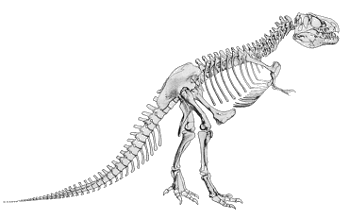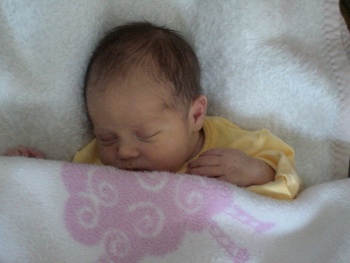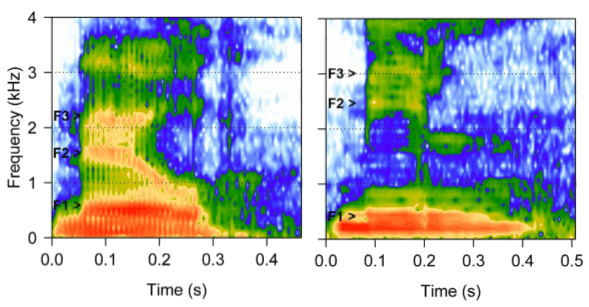Broad Shoulders and Broad Name
July 3, 2013
Some of my readers will remember the
comic strip character,
Alley Oop, created in 1932 by
American cartoonist,
Vincent T. Hamlin. Oop was a
caveman in a
Flintstones-like
suburbia of
prehistoric times. Oop's romantic interest, Ooola, was drawn to resemble Hamlin's
wife, Dorothy.
Cartoon cavemen coexisted with
dinosaurs, and Oop rode one of these like a
horse. He carried a
stone hammer, and he was dressed in a fur
loin cloth. Before
Dick Tracy got involved with the
Moon Maid, Alley Oop was transported by a
time machine to the present time to generate more interesting
plotlines.

A 2010 poll showed that 30% of Texans believe that humans and dinosaurs coexisted.[1]
(Skeleton of a Tyrannosaurus, modified 1915 image, via Wikimedia Commons.)
The name, Alley Oop, was apparently an intended corruption of the
French, "allez, hop," meaning "let's jump on our feet and go," as used by
tumblers and
gymnasts. It was likely chosen since it has an air of
masculinity. Why would a name sound masculine, or
feminine; and, is it just my false perception that male names have become somewhat more feminine sounding since the time of Alley Opp,
werewolf and
vampire role models notwithstanding? (See Table I)
Table I. Baby names in the United States at the time that the cartoon, Alley Oop, was created, 1932, and the latest year for which data are available, 2012. (US Social Security Administration data).[2]
| Rank | 1932 Male | 1932 Female | | 2012 Male | 2012 Female |
| 1 | Robert | Mary | | Jacob | Sophia |
| 2 | James | Betty | | Mason | Emma |
| 3 | John | Barbara | | Ethan | Isabella |
| 4 | William | Dorothy | | Noah | Olivia |
| 5 | Richard | Joan | | William | Ava |
| 6 | Charles | Patricia | | Liam | Emily |
| 7 | Donald | Margaret | | Jayden | Abigail |
| 8 | George | Helen | | Michael | Mia |
| 9 | Joseph | Shirley | | Alexander | Madison |
| 10 | Thomas | Doris | | Aiden | Elizabeth |
A team of
psychologists from
Queen Mary University of London (London, UK) wondered about the same thing; namely, what makes a name sound masculine. They've published their analysis as a
free, open access paper on
PLOS ONE.[3-5] Their conclusion is that "larger" sounding names, such as "Oop," are evocative of the deeper
vocalizations of larger individuals, so they are preferred by
parents for their
boys. Names with higher
frequency sounds are preferred for
girls.
They cite the following names as examples of this concept (note the "oop" in "Cooper").
| Boys | Jack | Lachlan | Cooper | Noah | Tom |
| Girls | Isabella | Olivia | Mia | Lily | Ella |

There's a quotation, variously attributed to Benjamin Franklin and Michael Faraday, "What use is a newborn baby?" This was supposedly said in reply to some pompous bureaucrat's asking why some scientific discovery was important.[6]
(Photo by Catalin Bogdan, via Wikimedia Commons.)
There's a
correlation in
Western societies between stature and
reproductive success. Taller men and shorter, slimmer women are considered more attractive.[3] Says study co-author,
Benjamin Pitcher, of Queen Mary's
School of Biological and Chemical Sciences
"In general, western societies tend to think of relatively taller men as more masculine and more successful with the opposite sex whereas shorter, slimmer women are perceived as having attractive feminine qualities. It seems that over time the English language has developed a preference for names that reflect our society's attitudes of what we deem to be attractive qualities in the different sexes."[4]
To study this effect, the research team divided
speech phonemes into size categories depending on their frequency content; for example,
/a/ and
/o/ are "large" sounds, whereas
/i/ and
/e/ are "small" sounds.[3] Large
vowels are produced by pulling the
tongue back in the
mouth, which produces a larger
resonant space and lower frequencies. Small vowels are produced with the tongue thrust forward, creating higher frequencies.

Spectrograms of the word, "mil," spoken by a 175 cm tall male (left) and a 165 cm tall female (right). Male speech formant frequencies (F1, F2 and F3) are lower, and there's more sound energy at lower frequencies. (A portion of fig. 1 of ref. 3, licensed under the Creative Commons Attribution License.)[3)]
The
dataset for this study was the most popular names from
England,
Australia and the
United States in the last
decade, about fifteen million names.[4] They used established
linguistic techniques to determine which of these contained small and large vowels sounds.[4] Parents were found to be 1-1/2 times more likely to assign a large vowel name to a son than a daughter.[3,5]
Although I think it's a reach, the authors say that this is an example of
biological evolution influencing
human culture.[4] As summarized by study co-author
Alan McElligott, also from Queen Mary's School of Biological and Chemical Sciences,
An evolutionary perspective might be that parents are choosing names that help to boost their son or daughter's success in life by increasing the chance of passing on their genes. In the future, we are interested in determining whether this gender bias in vowel sounds of first names is also seen in languages other than English."[4]
In short, if your son doesn't have a
soccer star physique, perhaps a soccer star name will help.
References:
- Ross Ramsey, "Poll: 30% of Texans believe humans and dinosaurs lived together," Houston Chronicle, February 18, 2010.
- Top 10 Baby Names, US Social Security Administration Web Site.
- Benjamin J. Pitcher, Alex Mesoudi and Alan G. McElligott, "Sex-Biased Sound Symbolism in English-Language First Names," PLos One, vol. 8, no. 6 (June 5, 2013), Document No. e64825, doi:10.1371/journal.pone.0064825.
- What's in a name?, Queen Mary University of London Press Release, June 5, 2013.
- Nicky Phillips, "Size matters in the naming game," The Age, June 10, 2013 .
- Donald Simanek, "Scientific Urban Legends," Lock Haven University Web Site.
Permanent Link to this article
Linked Keywords: Comic strip; Alley Oop; American; cartoonist; Vincent T. Hamlin; caveman; Flintstones; suburbia; prehistory; prehistoric times; wife; dinosaur; horse; stone tool; stone hammer; loin cloth; Dick Tracy; Moon Maid; time machine; plotline; Texas; Texan; skeleton; Tyrannosaurus; Wikimedia Commons; French language; acrobatics; tumbler; gymnastics; gymnast; masculinity; femininity; feminine; werewolf; vampire; role model; infant; baby; United States; Social Security Administration; psychologist; Queen Mary University of London (London, UK); open-access journal; free, open access paper; PLOS ONE; speech production; vocalization; parent; boy; frequency; girl; quotation; Benjamin Franklin; Michael Faraday; bureaucrat; science; scientific; correlation; Western society; reproductive success; Benjamin Pitcher; School of Biological and Chemical Sciences; English language; speech phoneme; vowel; tongue; mouth; resonance; resonant space; spectrogram; formant; sound energy; Creative Commons Attribution License; dataset; England; Australia; United States; decade; linguistic; biological evolution; human culture; Alan McElligott; gene; gender; bias; association football; soccer; celebrity; star; physical attractiveness; physique.